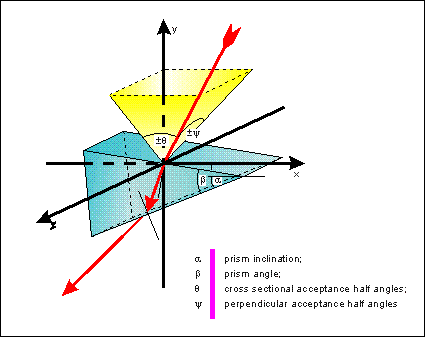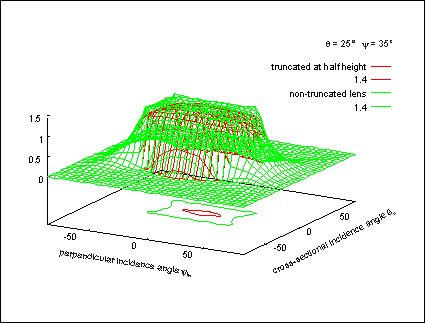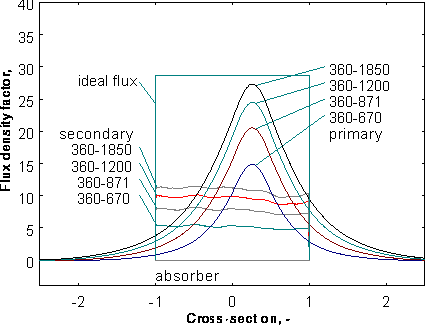 |
Fresnel Lens Solar Concentrator |
 |
Fresnel Lens Solar Concentrator |
Research Papers to download
This is the novel nonimaging Fresnel lens for solar concentration. It had its world premiere at the ISES Solar World Congress 1999, held in Jerusalem. Have a look! If you are here just to download some of the papers that exist concerning the lens, go to the bottom of the page. Thanks for your interest in our work.
Nice sun, isn't it? Beautiful lens, right? Steal it for your solar pages! This page deals with the solar Fresnel lens research going on at the Tokyo University of Agriculture and Technology, conducted by members of the Solar Energy Research Group.Until further notice, that means you are looking at my recent work, the most important research anyone can do!
But since you are here, have a look at what we are doing. Although the Tokyo University of Agriculture and Technology is not located all that close to the equator at 35° northern latitude there is some exciting research going on in solar thermal/pv energy engineering at our labs. We are developing an optimum shaped nonimaging Fresnel lens (those are the things you know from OverHead Projectors) for an evacuated tube type solar concentrator, or phtovoltaic applications. It should produce enough heat at sufficient temperature to drive an absorption heat pump cycle, which in turn will provide cooling, heating, air-conditioning for domestic and commercial applications, or temperature boosting for industrial processes. We are looking at a medium temperature solar thermal concentrator, something that produces heat around 100~250° Celsius in full operation. Due to its many potential uses, at a later stage the collector should be applicable not only to urban areas in industrialized countries but to stand-alone systems in the Developing World. The lens should also prove to be as least as good as (and possibly better than) the only commersially avainlable shaped Fresnel lens for photovoltaics, particularily in stand alone sytems with one-axis tracking, or no tracking at all.The lens is produced as acrylic sheet, thus substantially lowering the cost for concentrating devices. We assume at least a system cost reduction of 25% over flat plate photovoltaic systems.
Below, have a look at the working principle of nonimaging devices based on refractive geometrical optics. The solar ray (red) is refracted twice in a minimum deviation prism. All incident rays within the acceptance half angles will hit the absorber. Not accidentually, of course. Prism shape and position have been designed accordingly. For the case shown, the ray will reach the absorber at the very end.
 |
Just in case you wanted to see some results, fresh from the simulation, I included a graph depicting the performance of the lens, measured as optical projective concentration ratio. As you can see, incoming direct solar radiation is refracted by the lens prisms towards the absorber. The lens shown in this picture has been designed to collect all rays within a range of +/-25°, and +/-35° in the cross-sectional plane (as shown here), and in the plane perpendicular to it, respectively. This leads to a nice plateau in the optical concentration ratio.When truncating the lens at half height above the absorber, cutting off the prisms, the typical nonimaging shape becomes less defined, and it could be well worth to keep the lens in full shape. The prototype has been designed as truncated lens.
 |
Further questions and comments regarding refractive optics, insulation models, and medium temperature solar system solutions are welcome! My nightmares sometimes tell me there might still be a bug in that "C" program...Recently, the development of highly efficient photovoltaic devices, such as III-V multijunction cells, created a new imperative for solar concentrators: the flux distribution on the absorber must fulfill two conditions of uniformity. The flux must be locally homogeneous (the quantitative problem), and the color flux must be an exact reproduction of the solar spectrum (the qualitative problem). Both problems can be solved by using a kaleidoscope secondary concentrator, simply constructed by mirror walls over the absorber. The resulting flux is shown below.
 |
Download my work! It might look great in a frame over your bed! Mail me, if it doesn't!Some of the papers below do not represent the final version of the paper. Please confirm before quoting!
Papers:
Flux Uniformity and Spectral Reproduction in Solar Concentrators Using Secondary Optics (2001) R. Leutz, A. Suzuki, A. Akisawa, T. Kashiwagi; Proceedings ISES Solar Wordl Congress, 25-30 November, Adelaide, Australia.
The design quality of the optical elements in a solar photovoltaic concentrator are the key to enable the exploitation of the efficiency potentials of multijunction devices. The cells require homogeneous flux over the cell area and reproduction of the solar spectrum, for which the thickness of the layers was designed. We discuss the possible efficiency impact of inhomogeneous flux. To solve the problems, we propose the use of kaleidoskope-based secondary concentrators to achieve a uniform flux distribution and the reproduction of the spectrum of the incoming light. The (imperfect) design procedures of lens-based secondaries with the edge-ray principle are followed up.
Nonideal concentration of nonimaging linear Fresnel lenses (2001) R. Leutz, A. Suzuki, A. Akisawa, T. Kashiwagi; Proceedings of the SPIE International Symposium on Optical Science and Technology; Nonimaging Optics: Maximum Efficiency Light Transfer VI, Volume 4446, 29 July-3 August, San Diego, California.
Abstract: Our paper discusses geometrical and optical concentration ratios of the optimum nonimaging arched linear Fresnel lens which we designed earlier. This is a fundamental issue, with practical implications for the design of refractive nonimaging concentrators. The deliberations yield a better understanding of the way the refractive index of the thin lens, and the refractive index of the possible dielectricum between lens and receiver, as well as light incident in the plane of the secondary acceptance half angle~$\psi$, influence the performance of the nonimaging concentrator. Theoretical results are compared with tests of the existing prototypes of the nonimaging lens, used for the concentration of solar radiation. The novel nonimaging lens is put into the context of historic research, and is made comparable to other nonimaging concentrators, notably the Compound Parabolic Concentrator. We propose the use of a linear kaleidoskope-based secondary concentrator to achieve a uniform flux distribution and the reproduction of the spectrum of the incoming light.Flux densities in optimum nonimaging Fresnel lens solar concentrators for space (2000) R. Leutz, A. Suzuki, A. Akisawa, T. Kashiwagi; Proceedings of the 28th IEEE Photovoltaic Specialists Conference, 15-22 September, Anchorage, Alaska.
Abstract: This paper aims at the clarification of flux density issues in solar Fresnel lens concentrators for use in space photovoltaics. Using the novel nonimaging Fresnel lens designed and prototyped by the authors as example, flux densities are described as dependent on optical concentration ratio of the lens, solar disk size and related brightness distribution, and spectral dispersion of incident sunlight. Discussing the results of a simulation, the optimum linear nonimaging Fresnel lens concentrator is proposed in terms of concentration ratio, i.e. acceptance half angle pairs.Shaped nonimaging Fresnel lenses (2000) R. Leutz, A. Suzuki, A. Akisawa, T. Kashiwagi; Journal of Optics A: Pure and Applied Optics 2, 112-116
Abstract: Shaped nonimaging Fresnel lenses have been designed according to the edge ray principle, incorporating any combination of two acceptance half angle pairs. A numerical solution yields nonimaging lenses consisting of minimum deviation prisms. If the outer surface of the lens must be smooth, the lens shape will be convex. A linear lens prototype intended as concentrator for the collection of solar enery has been designed, manufactured and tested. Results in terms of flux distribution and optical concentration ratio are presented. Shaped nonimaging Fresnel lenses are suited for application as solar concentrators, or as collimators, or in lighting applications, where they can fulfil technological requirements as well as being adaptable to the necessities of fashionable design.Developments and designs of solar engineering Fresnel lenses (2000) R. Leutz, A. Suzuki, A. Akisawa, T. Kashiwagi; Proceedings Symposium on Energy Engineering (SEE 2000), Vol.2, 759-765, ISBN 1567001327, 9-13 January, Hong Kong.
Abstract: This paper deals with the suitability of Fresnel lenses of imaging and nonimaging designs for solar energy concentration. The paper' s scope is the review of long known, and recently developed Fresnel lenses, and the analyes of their characteristics for utilization as solar concentrators, putting an emphasis on a lens designed by the authors. Nonimaging optics are presented as offering the possibilities needed for a breakthrough of Fresnel lenses in commercial solar energy concentration, both in photovoltaic and thermal power conversion.Nonimaging Fresnel lens concentrator -- the prototype (1999) R. Leutz, A. Suzuki, A. Akisawa, T. Kashiwagi; Proceedings of the First International Power and Energy Conference (INT-PEC), ISBN 0732620945, 30 November-3 December, Gippsland, Australia.
Abstract: Design, manufacturing, and preliminary tests of the prototype of a novel nonimaging Fresnel lens solar collector of medium concentration are presented. The collector is evaluated due to the optical concentration ratio of its lens, and the flux density on the absorber. The latter is discussed in detail in its suitability for photovoltaic applications. A modular approach to power generation involving the nonimaging lens is presented. Costs of concentrating photovoltaic systems, as opposed to flat plate systems, are analysed. Concentrating systems are found to have a clear cost advantage over its competitors.Nonimaging Fresnel lens concentrators for photovoltaic applications (1999) R. Leutz, A. Suzuki, A. Akisawa, T. Kashiwagi; Proceedings ISES Solar World Congress, July 4-9, Jerusalem, Israel
Abstract: This study aims at clarifying the role of color aberrations in a novel nonimaging Fresnel lens of moderate concentration, intended for photovoltaic applications where homogeneous illumination is imperative. Refraction does indeed lead to color aberrations, but these are eliminated by rays of different color mixing on the absorber due to the nonimaging nature of the lens. Additionally, the manufacturing of the lens prototype, its working principle, and preliminary tests under the sun and under the moon are explained. An introduction deals with the metaphorical separation of photovoltaic concentration by means of lenses on the one hand, and solar thermal concentration with mirrors on the other.Design of a nonimaging Fresnel lens for solar concentrators (1999) R. Leutz, A. Suzuki, A. Akisawa, T. Kashiwagi; Solar Energy 65, 6, 379-388
Abstract: An optimum convex shaped nonimaging Fresnel lens is designed following the edge ray principle. The lens is evaluated by tracing rays and calculating a projective optical concentration ratio. This Fresnel lens is intended for use in evacuated tube type solar concentrators, generating mid-temperature heat to drive sorption cycles, or provide industrial process heat. It can also be used along with a secondary concentrator in photovoltaic applications.
Ralf Leutz
Physics Department
Philipps-University
35032 Marburg, Germany
phone +49-6421-2824148
fax +49-6421-2826535
email ralfsun@yahoo.com
http://geocities.datacellar.net/ralfsun